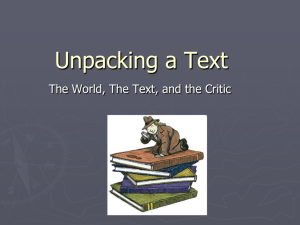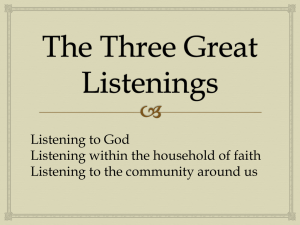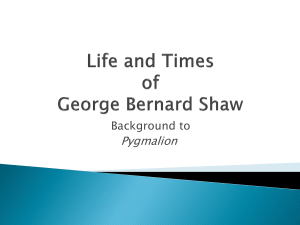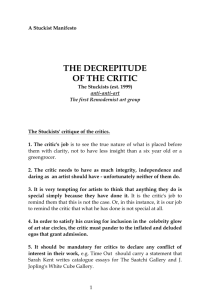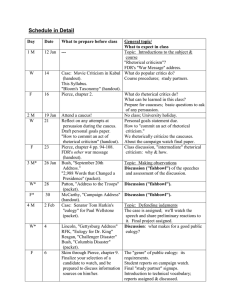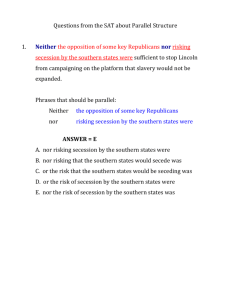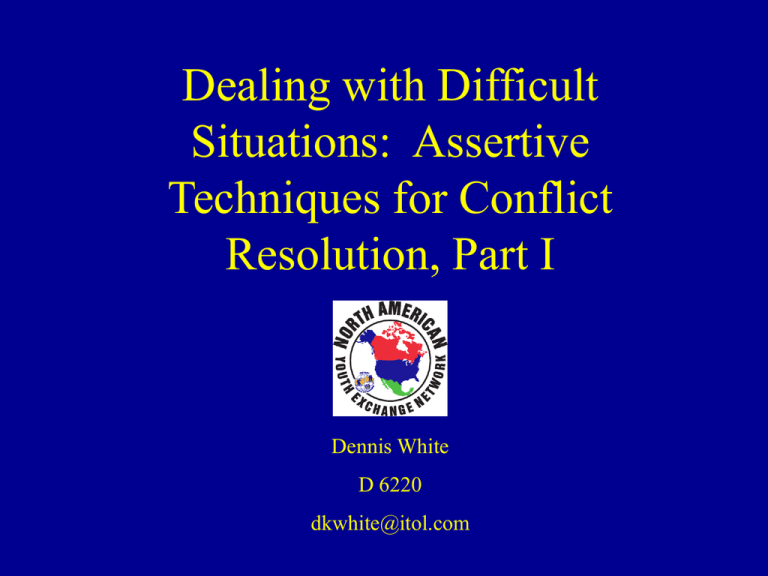
Dealing with Difficult
Situations: Assertive
Techniques for Conflict
Resolution, Part I
Dennis White
D 6220
dkwhite@itol.com
What factors influence
success or failure?
• In RYE Florida studying Resiliency
• Resilience is the ability to adapt well and
recover quickly after stress or adversity. If
you have a resilient personality, you are
better able to maintain poise and a healthy
level of physical and psychological wellness
in the face of life's challenges.
How do we prepare students?
•
•
•
•
•
•
Cultural Awareness
Area Studies
Language
Goals – of YE, personal goals
Chain of Contacts/Support
?
Possible Conflicts
• Host Parents
• Host Siblings
• School – teachers/administration
• Classmates
• Criticism of your native country
• Peer Pressure
Possible Hot Topics
• Health care
• Environmental & energy
policies
• Failure to support
democratic movements
• World Debt
• Can allies trust US?
• Drugs
• Drone attacks
• Nuclear weapons
• American popular culture
• Social unrest movements
• Death penalty
• Sex and pregnancy
• World policeman
• Intolerance of other
religious views
• Inept education system
• Capitalism
• Poverty
• Unfair use of world’s
resources
• NSA monitoring emails,
social media, & phones
• Islamic terrorism
Dysfunctional Example 1
• Critic: You Americans seem to think that
you can solve every problem in the world
by throwing money at it.
• Student: Well at least we don’t have people
living in cardboard shacks.
Dysfunctional Example 2
• Critic: You Americans are only 4.5% of the
world’s population, but you consume 26%
of the world’s energy.
• Student: You’re just jealous of what we
have.
Dysfunctional Example 3
• Critic: Why does your government say it is
on the side of democracy, but always seems
to side with established dictatorships when
an uprising happened?
• Student: Well, your government doesn’t do
much to protect religious minorities in your
country.
Dysfunctional Example 4
• Host Parent Critic: We really didn’t want to
host an exchange student – but we were
required to
• Student: Bursts into tears
Techniques from
Assertiveness Training
•
•
•
•
•
•
Active Listening
Negative Assertion
Fogging
“I” Messages
Broken Record
Bonus – Asking Questions
Active Listening
• Active Listening is a technique that allows
you to respond to the content and emotion
of what the other person is saying, without
agreeing or disagreeing. It puts the focus on
acknowledging the point of view of the
other person, which if done effectively,
often neutralizes the criticism and creates a
more meaningful dialogue.
Positive Approach—Active
Listening
• Critic: You Americans seem to think that
you can solve every problem in the world
by throwing money at it.
• Student: You feel like we try to solve all
the world’s problems with money.
Negative Assertion
• Negative Assertion is a technique used
when you are (or our country is) being
criticized, AND YOU AGREE WITH THE
CRITICISM. Instead of the frequent habit
people have of offering explanations or
excuses, even when they agree with the
criticism, it is easier, faster, and requires
much less energy to simply agree.
Positive Approach—Negative
Assertion
• Critic: You Americans are only 4.5% of the
world’s population, but you consume 26%
of the world’s energy.
• Student: I agree. We use an awful lot of
resources, and that really doesn’t seem fair,
does it?
Fogging
• Fogging is another assertiveness technique
that allows you to acknowledge the possible
truth, or opinion of the other person, while
maintaining a separate position of your
own. It is similar to active listening, and the
first part of a fogging response is very close
to active listening. But the second part,
maintaining a separate opinion, is in
addition to active listening.
Positive Approach--Fogging
• Critic: You Americans think every Muslim
is a terrorist. You even have pilots who
refuse to fly if Muslim clergy are aboard.
• Student: It may be that some Americans
stereotype all Muslims as terrorists, but I
know we are frightened of terrorism so
much that sometimes we are irrational about
it.
“I” Messages
• “I” Messages are very powerful statements
of thoughts, feelings, opinions, likes and
dislikes. When feelings are negative, “I”
Messages evoke much less defensive
reactions in the other person that typical
“You” Messages. Examples are “I feel
guilty intruding in your family when you
don’t really want me here.” vs. You make
me feel guilty being here.”
Positive Approach “I” Message
• Host Parent Critic – “We really didn’t want
to host an exchange student – but we were
required to.”
• Student: (active listening) “It must be very
frustrating having a stranger in your house
that you didn’t really want”.
• (“I” message) “I feel really bad about that.
I want to be the best exchange student I can
in your house.”
Broken Record
Broken Record is the calm, but firm
repetition of a simple message, usually
“No” or “No thank you”.
It is very effective when refusing a request
or pressure to do something one doesn’t
want to do
Bonus Positive Approach—
Ask questions!
• Critic: How can you criticize France’s
immigration policy on the Roma when you
arrest and deport peaceful Mexican whose
only crime is to cross the border to get jobs
in the US?
• Student: I don’t know about the Roma.
Can you tell me more about them?
• Student: What is France’s immigration
policy?
Role Playing
• Role playing is an experiential learning technique that
can help people practice real-life situations without the
risks of real-life consequences if things don’t go well.
• In role playing there can be no mistakes – just re-takes.
The role players can stop any time, rewind, and “do over”.
Role players can pause, re-group, ask for suggestions or try
several different versions of what they want to say.
The goal is to find comfortable, assertive, effective ways to
communicate in difficult situations.
Role Playing Preparation
1. How do I feel about the situation and/or what is my opinion?
2. What is (or are) my goal (s) in this situation?
3. What can I say or do to bring about the goal (s)?
Can be done in a variety of practice methods
Respond in way that encourages
dialog and discussion rather than
debate
Not all conflicts can be resolved
successfully. But these
techniques can help us figure out
if the other person is:
• Really interested in your answer
• Knowledgeable about the topic or is
repeating an inaccurate stereotype
• Just wants to get you mad
Handout and Powerpoint on
Dropbox
Article on www.yeoresources.org at
Dealing With Difficult Situations.doc
On the NAYEN Conference Web Site
Or, email Dennis at
dkwhite@itol.com


